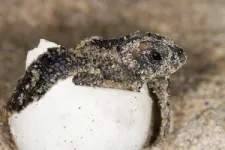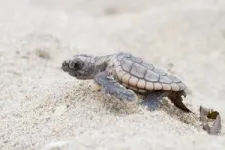(Press-News.org) Female sea turtles lay their eggs, cover the nest with sand and then return to the ocean, leaving them to develop and hatch on their own. From nest predators to rising temperatures, odds of survival are bleak. Once hatched and in the ocean, about one in 1,000 make it to adulthood.
Hatchling size matters. Larger hatchlings, which move faster, are more likely to survive because they spend less time on risky beach sands.
Research shows that both air and sand temperatures crucially impact sea turtle hatchlings. Cooler temperatures produce larger, heavier hatchlings with more males, while warmer temperatures accelerate hatching and offer predator protection. For endangered loggerhead (Caretta caretta) and green (Chelonia mydas) sea turtles, cooler and moister conditions result in stronger hatchlings. However, rising temperatures might shorten incubation periods, and erratic rainfall can disrupt growth, potentially affecting survival.
Balancing temperature and moisture is vital for the health of these vulnerable sea turtles. Too much moisture can be deadly for embryos.
An internationally collaborative study by Florida Atlantic University and led by the University of Tübingen in Germany, delves into how fluctuating rainfall impacts the development of sea turtle hatchlings, revealing that it has a more profound effect than changes in air temperature.
The research, which spans data from 37 beaches worldwide – a longitudinal study in Florida, and experimental studies on the Cape Verde Islands – shows that precipitation plays a crucial role in determining hatchling body size. Rainfall cools the beach surface and enhances the moisture needed for egg development, making it a better predictor of body size than temperature.
Results of the study, published in BMC Ecology and Evolution, reveal that the impact of rainfall varies between species. For loggerhead turtles, heavier rainfall results in hatchlings with smaller carapaces (shell) but greater weight, while green turtle hatchlings grow smaller carapaces without a change in body mass.
“Findings from our study highlight the need for more localized data on how regional weather influences incubation and hatchling development,” said Jeanette Wyneken, Ph.D., co-author and professor, Department of Biological Sciences, FAU Charles E. Schmidt College of Science. “These data are essential for refining conservation strategies to protect sea turtles amidst global warming.”
The study started with data from Boca Raton, comparing hatchling size (length, width, and mass) with local climate factors. Next, data were collected from 19 beaches with loggerhead hatchlings and 17 beaches with green turtle hatchlings. A third part of the study looked at hatchlings in Cabo Verde after a few days of rain during their dry season to see how precipitation affected their size.
In the Mediterranean, particularly on the beaches of Cyprus and Turkey, the dry season brings very little rain from the North Atlantic. For green turtles in these drier areas, the effects of precipitation become noticeable only after the dry season ends. In Florida, however, precipitation levels stay fairly consistent throughout the nesting season due to local weather patterns, though droughts and heatwaves typically occur in July and October.
“It's not clear exactly how rain affects hatchling size,” said Wyneken. “One idea is that rain cools the nests, which can change the temperature and impact the sex ratio of the hatchlings. This could lead to differences in hatchling size and shape, similar to how male and female hatchlings of other turtles, like the giant river turtle, have different shell shapes.”
As climate change shifts rainfall patterns – making wet areas wetter and dry areas drier – the impact on sea turtle nesting sites suggests that global conservation strategies for loggerhead and green sea turtles likely need to be updated.
“Effective management units for conservation should focus on regularly updating and including important nesting sites, highlighting the importance of local conservation efforts,” said Wyneken. “Analyzing local data from various nesting sites is crucial for understanding sea turtle nesting patterns. These local databases should be made more accessible and widely shared to improve our knowledge and support local conservation efforts.”
Study co-authors are first author Omar Rafael Regalado Fernández, Ph.D., University of Tübingen; Parima Parsi-Pour, The Humboldt University of Berlin; John A. Nyakatura, Ph.D., The Humboldt University of Berlin; and Ingmar Werneburg, Ph.D., University of Tübingen.
The research is supported by the German Research Foundation (Deutsche Forschungsgemeinschaft WE 5440/6-1).
- FAU -
About Florida Atlantic University:
Florida Atlantic University, established in 1961, officially opened its doors in 1964 as the fifth public university in Florida. Today, the University serves more than 30,000 undergraduate and graduate students across six campuses located along the southeast Florida coast. In recent years, the University has doubled its research expenditures and outpaced its peers in student achievement rates. Through the coexistence of access and excellence, FAU embodies an innovative model where traditional achievement gaps vanish. FAU is designated a Hispanic-serving institution, ranked as a top public university by U.S. News & World Report and a High Research Activity institution by the Carnegie Foundation for the Advancement of Teaching. For more information, visit www.fau.edu.
END
Cancer cells have voracious appetites. And there are certain nutrients they can’t live without. Scientists have long hoped they might stop tumors in their tracks by cutting off an essential part of cancer cells’ diet. But these cells are crafty and often find a new way to get what they need. How? By reprogramming their metabolism and switching to backup food supplies.
Now, Cold Spring Harbor Laboratory (CSHL) Assistant Professor Michael Lukey has found a way to deprive cancer cells of both a vital nutrient and their backup supply. In lab experiments with breast cancer cells, patient-derived tissue models, and mice, ...
Access to education is recognized as one of the pillars of sustainability; it is certainly a necessary foundation if we are to build a better world for ourselves and future generations. However, education needs to be not only accessible, but also inclusive. That is, it should extend to people with all kinds of disabilities and suit their particular needs.
According to a recent report by the World Health Organization, it is estimated that a striking 16% of the world’s population lives with some form of disability. Considering there are about 1.5 billion English language teachers (ELTs) worldwide, there is a great need for adequately trained ELTs that can teach students with ...
Healthcare is undoubtedly crucial for everyone. As individuals age, the risk for health issues and related expenses increases. Consequently, many countries have universal healthcare systems, primarily funded through tax and insurance, to ensure access to essential healthcare services. However, this system is under a heavy fiscal burden since the aging population has increased manyfold, owing to decreasing fertility rates and increasing life span. To sustain the system, governments must face the herculean task of persuading citizens to contribute more to health insurance.
In a recent study, a research team consisting of Associate ...
SAN ANTONIO, TEXAS — One master’s program. Two universities. Two countries. Two degrees. Students from UTSA and Tecnológico de Monterrey (Tec de Monterrey) in Mexico are swapping campuses, as the two universities jointly launch a unique new degree program this fall.
The collaborative program offers students the distinctive opportunity to take high-quality courses at both institutions and earn two degrees: a Master of Science in Information Technology with a concentration in cybersecurity from UTSA and a Master in Cybersecurity from Tec de Monterrey.
The program will enable students to advance their cybersecurity ...
Type 2 diabetes and prediabetes are associated with accelerated brain ageing, according to a new study from Karolinska Institutet in Sweden published in the journal Diabetes Care. The good news is that this may be counteracted by a healthy lifestyle.
Type 2 diabetes is a known risk factor for dementia, but it is unclear how diabetes and its early stages, known as prediabetes, affect brain ageing in people without dementia. Now, a comprehensive brain imaging study shows that both diabetes and prediabetes can be linked to accelerated brain ageing.
The study included more than 31,000 people between 40 and ...
New research suggests that epigenetic markers in the blood could be useful for understanding dementia risk.
Two linked papers from the University of Exeter and Maastricht University have together progressed research to show the potential for DNA methylation, an epigenetic marker, in understanding how genetics and lifestyle factors influence dementia risk.
DNA methylation is a chemical tag added to DNA, which can turn genes on and off. Genetic and lifestyle factors can alter the levels of the DNA methylation tag on genes, with some of these factors already known to increase the risk of developing dementia. By assessing DNA methylation this can help scientists ...
EMBARGO UNTIL 6 A.M. EST, WEDNESDAY AUG. 28, 2024.
In-person contact helps lead to lower levels of loneliness in older people, but other ways of staying in touch, such as phoning, emailing or texting, are not as effective in lowering loneliness, a team of researchers at The University of Texas at Austin and the University of Michigan have found.
The findings, out today in the The Journals of Gerontology: Series B Psychological Science, have implications for the health and well-being of many older people.
“We were interested to see how older adults react ...
The renewable raw material wood is climate-neutral and at the same time light and strong, making it fundamentally attractive for use in vehicle manufacturing. One challenge to date has been joining the wood and the other materials in the vehicle, such as metals and polymer composites, in a robust way. The research team led by Sergio Amancio from the Institute of Materials Science, Joining and Forming of Graz University of Technology (TU Graz) - Gean Marcatto, Awais Awan, Willian Carvalho and Stefan Herbst - has now successfully tested two techniques by which extremely strong joints can be achieved without using adhesives or screws. ...
London, United Kingdom – 28 August 2024: New research presented at this year’s ESC Congress 2024 in London, UK (30 Aug – 2 Sept) shows that performing echocardiograms remotely using a 5G cellular network has similar accuracy to those performed in person by cardiologists.
“Comprehensive echocardiographic exam with a 5G cellular network and robotic arm-based remote system is feasible with relatively good diagnostic accuracy,” said study author Dr Yu Liu, Zhongshan Hospital, Shanghai, China.
Echocardiography is the test-of-choice for the ...
London, United Kingdom – 28 August 2024: New research presented at this year’s ESC Congress 2024 in London, UK (30 Aug – 2 Sept) shows that, among patients admitted to the intensive cardiac care unit (ICCU), those with a recent history of recreational drug use are three times more likely than those with no history to experience a repeat serious cardiovascular event within one year.
“Among patients admitted to the intensive cardiac care unit (ICCU), systematic screening for recreational drugs evidenced a significant prevalence ...








